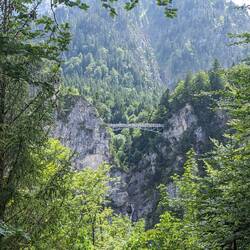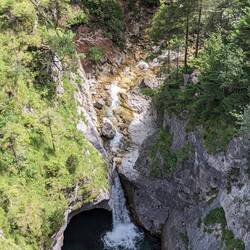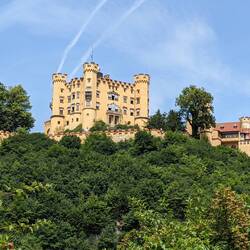- Show trip
- Add to bucket listRemove from bucket list
- Share
- Jul 23, 2023, 3:07pm
- ☁️ 23 °C
- Altitude: 968 m
 GermanyFree State of BavariaSchwangauHohenschwangauNeuschwanstein Castle47°33’28” N 10°45’0” E
GermanyFree State of BavariaSchwangauHohenschwangauNeuschwanstein Castle47°33’28” N 10°45’0” E
Neuschwanstein Castle
 July 23, 2023 in Germany ⋅ ☁️ 23 °C
July 23, 2023 in Germany ⋅ ☁️ 23 °C
The main event for our visit to Munich and for our day trip was seeing Schloss Neuschwanstein - Neuschwanstein Castle - in the Bavarian Alps. Like Linderhof, it was constructed by (or perhaps for and on the orders of) King Ludwig II of Bavaria. It was built between 1869 and 1886 and today is perhaps the best-known castle in Germany. Unlike Linderhof (but like his third castle, which we did not visit) at the time of Ludwig's death in 1886 the castle was still incomplete, both structurally and inside.
Ludwig described himself as a fairytale king, and spent much of his time fantasising about times gone by when monarchs held absolute power (as Bavaria was a constitutional monarchy). This manifested both in his obsession with Louis XIV seen at Linderhof and in a fascination with medieval Europe, when kings wielded greater power than his political context granted him.
At the same time, Ludwig held a deep love for the operas of Richard Wagner, a German composer (and famed anti-Semite) about 35 years his senior. In addition to providing Wagner with significant funding over his life and particularly in his early years as king, Ludwig was greatly inspired by the romanticism of Wagner's works. Many references to and depictions of Wagner's works can be found in Neuschwanstein's architecture and interior decorating.
Even with his fairytale fantasies, Ludwig championed new technologies. Most notably, his bedchamber contained running water from a nearby mountain stream immediately accessible by tap, and the castle possessed the first working telephone in Bavaria.
At the time of Ludwig's death at age 40, the castle was unfinished. Only a handful of rooms inside were completed - the beautiful throne room lacks a throne, for example - and the planned construction of a chapel and a further courtyard below the large balcony never eventuated. Even despite this, Neuschwanstein is one of the largest castles in Europe and continues to stand today as a monument to Ludwig II's fantasies of both power and escape.Read more





















Traveler Impressive
Impressive
Traveler The castles are increadable. They look so big and I can’t imagine how many people were involved in building them or how much money it cost.